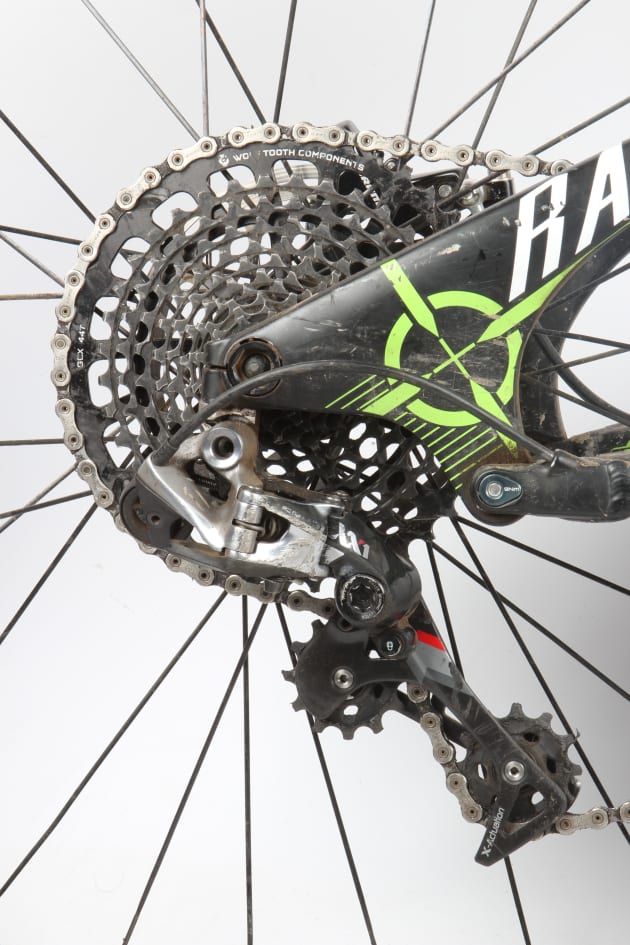Wolf Tooth 44T cog
In the ’90s we had Ringle and Paul components offering Rasta coloured anodised components, now we have Wolf Tooth, One Up, Absolute Black, Lindarets and others making all manner of aftermarket drivetrain solutions. It seems that small brands like these are always lurking in the shadows and looking for opportunities to innovate.
Wolf Tooth gained notoriety by making narrow/wide tooth chainrings to fit Shimano cranks but they’ve since branched out to offer everything from direct mount front derailleur tab covers to low-profile rebound knobs for Fox Float shocks. For some time they’ve offered range expanding 40 and 42 tooth cogs for 10-speed cassettes, and now they’re making a similar product for SRAM 11-speed.

Rather than fitting inboard of the cassette (as per the 10-speed versions), this $126 dinner plate actually replaces the 42 cog on a SRAM X01 or XX1 cassette. This is particularly interesting as SRAM’s top-end cassettes aren’t meant to be serviceable and they come as one cohesive unit. Fitting the Wolf Tooth cog involves prying the largest alloy cog away from the one-piece steel X-Dome cassette, then pressing on the aftermarket replacement. We were intrigued and decided to try it out for ourselves.
Wolf Tooth offers both 42 and 44 tooth options. With most of the cogs machined from 4130 chromoly steel, SRAM’s X-Dome cassettes are very durable, however the big cog is alloy and can wear faster than the rest of the cassette—especially if you do lots of climbing. That’s where the Wolf Tooth 42 cog comes into play; as a direct aftermarket replacement that keeps the ratios the same. We tried the 44 tooth option to increase our overall gear spread. Whichever option you’re looking at, the fitment process is the same.
SRAM Sacrilege
With the cassette removed you need to lever the alloy cog away from the main part of the cassette. We used a large flat bladed screwdriver and gradually worked our way around the cog as per their instructions. With the cassette apart, you line up the new cog and press the tabs into the corresponding holes with a pair of pliers. It sounds rather butcherous but the process was surprisingly simple and should be manageable for anyone with a moderate level of mechanical aptitude.

The weight gain was really minimal; our X01 cassette went from 265g up to 275g. With the wheel back on the bike, we needed to wind in the B-tension screw so the rear derailleur would clear the new super-sized cassette. I tried this setup on a few different bikes with varied results. In most cases the derailleur had no problems pushing the chain up to the 44 cog but the shifting became slightly less responsive lower down on the cassette. The B-tension adjustment places the derailleur further away from the cogs and this may lead to some vagueness. Thankfully there was next to no compromise in the shift performance on my main bike. With smooth running cables and a straight derailleur hanger, the shift quality should still be quite acceptable.
Now to the inevitable question of ‘who needs a 44 tooth cog?’ Well the stock 10-42 offers plenty of range and many riders are content with the SRAM 1X product. That said, European riders still favour the wider gear range offered by a 2X drivetrain; they’ve got some big mountains to pedal up! If you live somewhere with long steep hills, you too may appreciate a wider gear range.

A standard SRAM 11-speed cassette offers a total gear spread of 420% and the 44 cog takes this out to 440%. It still doesn’t match the 505% spread of a Shimano 2x11 drivetrain but it hedges a tiny bit closer.
How you use the wider range is up to you. For some it will provide a slightly lower bailout gear for those super-steep pinches. Others will fit a larger chainring for fast fire road pedalling; run the 44 cog with a 34 tooth chainring and you get exactly the same low gear as the stock cassette with a 32 tooth chainring, the top-end however will be 6.4% higher. Of course fitting the 44 cog creates a bigger gap between your second gear and the first; it goes from a 16.9% change in ratios up to a 22.2% jump. For me this wasn’t a problem but XC/marathon racer-types may find this annoying.
Finally, ripping apart your $400 cassette to fit one of these aftermarket cogs is not approved by SRAM in any way—in short they don’t approve of this mod and it’ll void any warranty you may hold on the drivetrain. Still, if you’re chasing a wider gear range without the complexity of a multi-ring drivetrain, you may be willing to take that one on the chin.
Wolf Tooth Components / www.wolftoothcomponents.com






